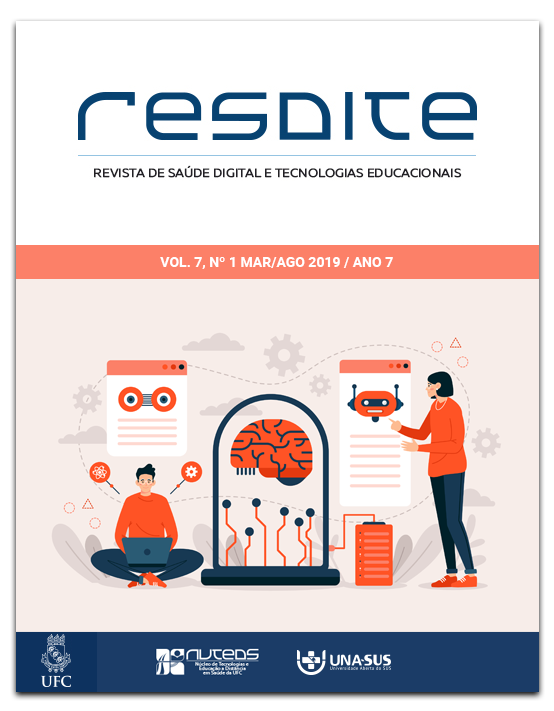Wayback machine e príons: explorando a informação em saúde em arquivos da internet
Palavras-chave:
Proteínas Priônicas, Sistemas de Informação, Big DataResumo
A Wayback Machine (WM) permite visualizar páginas da World Wide Web arquivadas, reconstruindo o fluxo de informações sobre um tópico durante um período de tempo definido. Objetivos: Delinear e comparar a evolução histórica da apropriação do conceito de príon pela comunidade científica e popular. Metodologia: Estudo exploratório no Pubmed (PM) e WM, utilizando como termo de entrada “Prion” ou “Scrapie”. Os dados do WM foram selecionados seguindo uma metodologia de amostragem aleatória trimestral. Resultados: Há um grande aumento no fluxo de publicações no PM nos anos posteriores a 1996, totalizando 10.551 artigos até 2018. Discussão: Nota-se especulação inicial na sociedade, enquanto o conhecimento sobre o príon não foi consolidado, com reação de intenso alarmismo, sendo isso amenizado com a construção e disseminação do conhecimento científico. Conclusão: O WM provou ser uma ferramenta inovadora e prática a ser empregada para analisar a construção historiográfica de um conceito científico.
Downloads
Referências
Murphy J, Hashim NH, O’CONNOR P. Take me back: validating the wayback machine. Journal of Computer-Mediated Communication. 2007; 13(1): 60-75.
Rogers R. Doing Web history with the Internet Archive: screencast documentaries. Internet Histories. 2017; 1(1-2): 160-172.
Veronin MA. ‘URL 404 File Not Found’: dealing with the transient nature of the Web. Journal of Audiovisual Media in Medicine. 2003; 26(4): 153-155.
Veronin MA, Ramirez G. The validity of health claims on the World Wide Web: a systematic survey of the herbal remedy Opuntia. American Journal of Health Promotion. 2000; 15(1): 21-28.
Pearce D, Charlton BG. Plagiarism of online material may be proven using the Internet Archive Wayback Machine (archive. org). Medical Hypotheses. 2009; 73(6): 875.
Nunes Vaz, F, Dewes, H., Domingos Padula, A., Talamini, E. Meat market reaction towards mass media and science communication on bovine spongiform encephalopathy. Journal of Science Communication 2013; 12(2), A02.
Bussard AE. A scientific revolution? The prion anomaly may challenge the central dogma of molecular biology. EMBO reports. 2005; 6(8): 691-694.
Lin M, Thoma B, Trueger NS, Ankel F, Sherbino J, Chan T. Quality indicators for blogs and podcasts used in medical education: modified Delphi consensus recommendations by an international cohort of health professions educators. Postgraduate medical jornal. 2015; 91(1080): 546-550.
Johnson R, Kuby P. Estat 4LTR. São Paulo: Cengage Learning; 2013.
Tilston CH, Sear R, Neale R, Gregson K. The effect of BSE: consumer perceptions and beef purchasing behaviour. British Food Journal. 1992; 94 (9): 23-26.
Greger M. Mad Cow Disease "Much More Serious Than AIDS". 1996 Dez 21 [cited 2019 Feb 5]. Disponível em: https://web.archive.org/web/19990127212708/http://arrs.envirolink.org/AnimaLife/spring94/madcow.html.
Mainland DD, Ashworth SW. The effect of BSE on the revenue from beef fatstock. Journal of agricultural economics. 1992; 43(1): 96-103.
Prusiner, SB. Prion diseases of humans and animals. Ellis Horwood Limited. 1992.
Prusiner SB. Prions. Proceedings of the National Academy of Sciences. 1998; 95(23): 13363-13383.
Tong S, Ahlgren P. Evolution of three Nobel Prize themes and a Nobel snub theme in chemistry: a bibliometric study with focus on international collaboration. Scientometrics. 2017;112(1):75-90.
Vallabh S. Welcome to PrionAlliance.org. 2012 Oct 23 [cited 2019 Mar 25]. Disponível em: https://web.archive.org/web/20121209093141/http://www.prionalliance.org/
Minikel EV, Vallabh SM, Orseth MC, Brandel JP, Haïk S, Laplanche JL, Zerr I et al. Age at onset in genetic prion disease and the design of preventive clinical trials. Neurology. 2019; 93(2): e125-e134.
Ward H, Molesworth A, Holmes S, Sinka K. Public health: surveillance, infection prevention, and control. Handbook of Clinical Neurology. 2018; 153: 473-484.
Brown P, Brandel JP, Sato T, Nakamura Y, MacKenzie J, Will RG, Schonberger LB. (2012). Iatrogenic Creutzfeldt-Jakob disease, final assessment. Emerging infectious diseases. 2012; 18(6): 901.
Bonda DJ, Manjila S, Mehndiratta P, Khan F, Miller BR., Onwuzulike K et al. Human prion diseases: surgical lessons learned from iatrogenic prion transmission. Neurosurgical focus. 2016; 41(1):10.
Zerr I, Schmitz M. Genetic Prion Disease. 2003 In: Adam MP, Ardinger HH, Pagon RA, et al., editors. GeneReviews® [Internet]. Seattle (WA): University of Washington, Seattle; 1993-2021. Disponível em: https://www.ncbi.nlm.nih.gov/books/NBK1229/
Downloads
Publicado
Edição
Seção
Licença
Os originais aceitos e publicados tornam-se propriedade da Revista Brasileira de Tecnologias Educacionais em Saúde. A revista adota a Licença Creative Commons, CC BY-NC. É possível acessar, baixar (download), copiar, imprimir, compartilhar e distribuir os artigos publicados conosco, desde que para uso não comercial, mencionando a RESDITE e atribuindo os créditos de autoria. A revista permite que os autores distribuam a versão do trabalho publicada conosco (ex.: em repositórios institucionais), desde que seja reconhecida a autoria e a publicação inicial na RESDITE.

